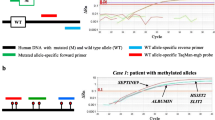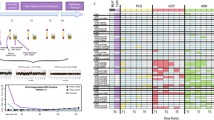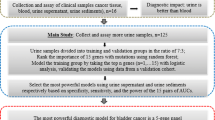Abstract
Background
Tissue genotyping is a more useful approach than using blood genomic DNA, because the tumor tissues can reflect the effects of somatic mutations in cancer. We investigated the value of the human oxoguanine glycosylase (hOGG1) genotype determined in tumor tissues as a prognostic indicator for bladder cancer (BC) using a novel technological approach.
Methods
A total of 335 DNA samples from patients with primary BC were analyzed by peptide nucleic acid (PNA)-mediated real-time polymerase chain reaction (PCR) clamping to characterize the association between genetic polymorphisms within hOGG1 codon 326 and the clinicopathological characteristics of primary BC patients.
Results
Tumor stage and number were significantly associated with the hOGG1 codon 326 genotype in nonmuscle invasive bladder cancer (NMIBC) patients. Compared with Cys326Ser and Ser326Ser, the Cys326Cys genotype had a greater progression-free survival benefit in patients with muscle invasive bladder cancer (MIBC). Univariate and multivariate Cox regression analyses indicated that the hOGG1 Cys326Cys genotype has a protective effect against progression in MIBC (hazard ratio, 0.360 and 0.314, respectively).
Conclusions
The hOGG1 tissue genotype is associated with aggressive clinicopathological features in NMIBC and with progression in patients with MIBC. Results suggest that the hOGG1 tissue genotype represents a promising marker for assessing BC prognosis in the clinical setting.


Similar content being viewed by others
References
Hirao Y, Kim WJ, Fujimoto K. Environmental factors promoting bladder cancer. Curr Opin Urol. 2009;19:494–9.
Ames BN, Gold LS, Willett WC. The causes and prevention of cancer. Proc Natl Acad Sci USA. 1995;92:5258–65.
Michaels ML, Cruz C, Grollman AP, Miller JH. Evidence that MutY and MutM combine to prevent mutations by an oxidatively damaged form of guanine in DNA. Proc Natl Acad Sci USA. 1992;89:7022–5.
Berwick M, Vineis P. Markers of DNA repair and susceptibility to cancer in humans: an epidemiologic review. J Natl Cancer Inst. 2000;92:874–97.
Friedberg EC. How nucleotide excision repair protects against cancer. Nat Rev Cancer. 2001;1:22–33.
Kim EJ, Jeong P, Quan C, Kim J, Bae SC, Yoon SJ, et al. Genotypes of TNF-alpha, VEGF, hOGG1, GSTM1, and GSTT1: useful determinants for clinical outcome of bladder cancer. Urology. 2005;65:70–5.
Sugimura H, Kohno T, Wakai K, Nagura K, Genka K, Igarashi H, et al. hOGG1 Ser326Cys polymorphism and lung cancer susceptibility. Cancer Epidemiol Biomarkers Prev. 1999;8:669–74.
Xing DY, Tan W, Song N, Lin DX. Ser326Cys polymorphism in hOGG1 gene and risk of esophageal cancer in a Chinese population. Int J Cancer. 2001;95:140–3.
Orum H, Nielsen PE, Egholm M, Berg RH, Buchardt O, Stanley C. Single base pair mutation analysis by PNA directed PCR clamping. Nucleic Acids Res. 1993;21:5332–6.
Nagai Y, Miyazawa H, Huqun, Tanaka T, Udagawa K, Kato M, et al. Genetic heterogeneity of the epidermal growth factor receptor in non-small cell lung cancer cell lines revealed by a rapid and sensitive detection system, the peptide nucleic acid-locked nucleic acid PCR clamp. Cancer Res. 2005;65:7276–82.
Babjuk M, Oosterlinck W, Sylvester R, Kaasinen E, Bohle A, Palou-Redorta J. EAU guidelines on non-muscle-invasive urothelial carcinoma of the bladder. Eur Urol. 2008;54:303–14.
Greene FL. The American Joint Committee on Cancer: updating the strategies in cancer staging. Bull Am Coll Surg. 2002;87:13–5.
Stenzl A, Cowan NC, De Santis M, Jakse G, Kuczyk MA, Merseburger AS, et al. The updated EAU guidelines on muscle-invasive and metastatic bladder cancer. Eur Urol. 2009;55:815–25.
Chen CY, Shiesh SC, Wu SJ. Rapid detection of K-ras mutations in bile by peptide nucleic acid-mediated PCR clamping and melting curve analysis: comparison with restriction fragment length polymorphism analysis. Clin Chem. 2004;50:481–9.
Beau-Faller M, Legrain M, Voegeli AC, Guerin E, Lavaux T, Ruppert AM, et al. Detection of K-Ras mutations in tumour samples of patients with non-small cell lung cancer using PNA-mediated PCR clamping. Br J Cancer. 2009;100:985–92.
Wikman H, Risch A, Klimek F, Schmezer P, Spiegelhalder B, Dienemann H, et al. hOGG1 polymorphism and loss of heterozygosity (LOH): significance for lung cancer susceptibility in a caucasian population. Int J Cancer. 2000;88:932–7.
Gangwar R, Ahirwar D, Mandhani A, Mittal RD. Do DNA repair genes OGG1, XRCC3 and XRCC7 have an impact on susceptibility to bladder cancer in the North Indian population? Mutat Res. 2009;680:56–63.
Huang M, Dinney CP, Lin X, Lin J, Grossman HB, Wu X. High-order interactions among genetic variants in DNA base excision repair pathway genes and smoking in bladder cancer susceptibility. Cancer Epidemiol Biomarkers Prev. 2007;16:84–91.
Sanyal S, De Verdier PJ, Steineck G, Larsson P, Onelov E, Hemminki K, et al. Polymorphisms in XPD, XPC and the risk of death in patients with urinary bladder neoplasms. Acta Oncol. 2007;46:31–41.
Acknowledgment
This research was supported by the Basic Science Research Program through the National Research Foundation of Korea (NRF) funded by the Ministry of Education, Science and Technology (2010-0001730).
Conflict of interest statement
We declare that we have no conflict of interest.
Author information
Authors and Affiliations
Corresponding author
Rights and permissions
About this article
Cite this article
Ha, YS., Yan, C., Kim, I.Y. et al. Tissue hOGG1 Genotype Predicts Bladder Cancer Prognosis: A Novel Approach Using a Peptide Nucleic Acid Clamping Method. Ann Surg Oncol 18, 1775–1781 (2011). https://doi.org/10.1245/s10434-010-1500-7
Received:
Published:
Issue Date:
DOI: https://doi.org/10.1245/s10434-010-1500-7




